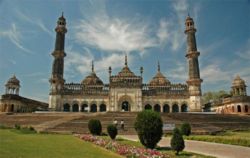Lucknow
| Lucknow | |
|---|---|

| |
| Presidency: Bengal | |
| Coordinates: | 26.812800°N, 80.901300°E |
| Altitude: | 123 m (404 ft) |
| Present Day Details | |
| Place Name: | Lucknow |
| State/Province: | Uttar Pradesh |
| Country: | India |
| Transport links | |
| Oudh and Rohilkhand Railway Rohilkund and Kumaon Railway | |
Lucknow is a city in north-central India, about 250m/400km south-west of Delhi. It was the scene of a major siege during the Indian Mutiny, when the Residency was defended against great odds by a small group of soldiers and civilians, including schoolboys from La Martiniere College.
Contents
History
The Indian Mutiny
See also Fibis Lucknow resources
Summary of events:
Lucknow was one of the major centres of the Indian Mutiny. Sir Henry Lawrence became Chief Commissioner of the Province of Oudh (Awadh) on March 20th 1857. The garrison at the time consisted of HM 32nd Regiment of Foot, the 7th Native Cavalry, the 13th Regiment of Bengal Native Infantry, the 48th Regiment of Bengal Native Infantry and the 71st Regiment of Bengal Native Infantry, with Indian soldiers outnumbering Europeans 10 to 1. Unrest was evident in the city for several months and when the mutiny reached the province, Lawrence fortified the Residency at Lucknow and took the British inhabitants into the compound. The rebellion broke out on the 30th May and a 87 day siege of the Residency ensued, with Lawrence killed in the first few days.
Forces led by Sir Henry Havelock and Sir James Outram reached Lucknow in September (the First Relief of Lucknow). After taking the Alambagh, this became the headquarters for subsequent actions at Lucknow. Under heavy assault from the rebels, they were unable to evacuate the Residency as intended and instead bolstered the garrison there, a second siege ensuing for six weeks. The Second Relief came in November when Sir Colin Campbell reached Lucknow. On the 16th November, 2000 rebel sepoys besieged at the Secundrabagh villa were massacred when the 93rd Highlanders and the 4th Punjabi Infantry took the estate. Campbell managed to evacuate the besieged Europeans at the Residency, but Havelock died before he was able to leave the city. Outram stayed and defended Lucknow until the following March, when Campbell retook the city. During this action Major Hodson (Commander of Hodson's Horse) was killed and buried in the grounds of La Martiniere College.
Actions timeline:
| Siege of Lucknow | 1 July to 27 Sept 1857 |
| Battle of Alambagh (Lucknow) Sept 1857 | 23 September 1857 |
| First Lucknow Relief | 29 September 1857 |
| Battle of Alambagh (Lucknow) Nov 1857 | 12 November 1857 |
| Second Lucknow Relief | 17 November 1857 |
| Defence of Alambagh (Lucknow) | 27 November 1857 to 10 March 1858 |
| Battle of Gailee by Lucknow | 22 December 1857 |
| Recapture of Lucknow | 1-21 March 1858 |
| Battle of Begum Kothi (Lucknow) | 11 March 1858 |
| Battle of Moosa Bagh (Lucknow) | 19 March 1858 |
Memorials:
- Memorial to Henry Lawrence in the Christ Church Cathedral
- Memorial to James Outram in the Christ Church Cathedral
- Thomas Henry Kavanagh was a civilian who won the Victoria Cross for his action during the Siege. One of those inside the Residency, he disguised himself as a sepoy in order to escape undetected to the Alambagh and guide Campbell's forces into Lucknow for the Second Relief. Kavanagh's memorial in the All Saints Garrison Church can be view on the FIBIS database.
Transport
Lucknow became an important railway hub for both broad and metre gauge lines, headquarters of the Oudh and Rohilkhand Railway (which also had two major workshops situated close by, at Alambagh and Charbagh), and a terminus for the Rohilkund and Kumaon Railway's line from Bareilly.
Churches
Anglican:
- All Saints Garrison Church
- Christ Church Cathedral
- St Mary's at the Residency - Photos of the cemetery on the FIBIS database
Roman Catholic
- St Joseph's Cathedral
Education
See also Schools
- Canning College - founded 1864
- Colvin Taluqdars' College - a Public School, established 1889
- Jubilee High School
- Loreto Convent - Catholic school, founded 1872
- La Martiniere College - boys school established 1845, girls schools established 1869. Photos on the FIBIS database.
- Reid Christian College
- St. Francis' School and Orphanage - Catholic school, founded 1885
FIBIS resources
As well as those resources already included in appropriate sections, the following can be found on the FIBIS database:
- Photographs of Lucknow by C Jackson, a painter and gilder for the Maharaja of Balrampur.
- Map of the Residency
- Letter from Lieutenant Clifford Mecham sent during the Defence of Lucknow 1857
- Miscellaneous Lucknow photographs
External links
- "Lucknow" Love to Know 1911.
- "Siege of Lucknow" Wikipedia.
- "Lucknow" Wikipedia.
- La Martiniere College, Lucknow Wikipedia